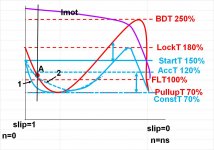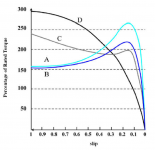Hello,
Please confirm the two scenarios below, each of which is regarding a NEMA A motor with across the line starting:
Scenario 1:
NEMA A motor with the following speed torque characteristics:
Locked rotor = 180% FLT
Pull up torque = 70% FLT
BDT = 250% FLT
Load Profile with the following characteristics:
Starting Load Requirement = 150% FLT
Acceleration Load Requirement = 120% FLT
Constant Velocity Load Requirement (moving at the rated slip speed) = 70% FLT
I assume in this scenario the motor will start, begin to accelerate, get bogged down because the pull up torque availability from the motor is less than the Acceleration Load Requirement of the load. The motor will slow down head toward locked rotor torque. Since locked rotor torque is higher than the acceleration requirement the load will continue to move but very very slowly. This will cause a lot of heat generated in the motor and eventually fail. The motor will never get to full rated speed.
================================================================
Scenario 2:
NEMA A motor with the following speed torque characteristics:
Locked rotor = 125% FLT
Pull up torque = 70% FLT
BDT = 250% FLT
Load Profile with the following characteristics:
Starting Load Requirement = 120% FLT
Acceleration Load Requirement = 130% FLT
Constant Velocity Load Requirement (moving at the rated slip speed)= 70% FLT
I assume in this scenario it would be similar to scenario 1 where since the pull up load capability of the motor is less than what the load requires, the motor will slow down to try and get to the locked rotor torque. Since in this scenario the locked rotor torque capability of the motor is less than the acceleration load requirement, the motor will come to a complete stop and draw locked rotor current until it burns itself out.
Please confirm the two scenarios below, each of which is regarding a NEMA A motor with across the line starting:
Scenario 1:
NEMA A motor with the following speed torque characteristics:
Locked rotor = 180% FLT
Pull up torque = 70% FLT
BDT = 250% FLT
Load Profile with the following characteristics:
Starting Load Requirement = 150% FLT
Acceleration Load Requirement = 120% FLT
Constant Velocity Load Requirement (moving at the rated slip speed) = 70% FLT
I assume in this scenario the motor will start, begin to accelerate, get bogged down because the pull up torque availability from the motor is less than the Acceleration Load Requirement of the load. The motor will slow down head toward locked rotor torque. Since locked rotor torque is higher than the acceleration requirement the load will continue to move but very very slowly. This will cause a lot of heat generated in the motor and eventually fail. The motor will never get to full rated speed.
================================================================
Scenario 2:
NEMA A motor with the following speed torque characteristics:
Locked rotor = 125% FLT
Pull up torque = 70% FLT
BDT = 250% FLT
Load Profile with the following characteristics:
Starting Load Requirement = 120% FLT
Acceleration Load Requirement = 130% FLT
Constant Velocity Load Requirement (moving at the rated slip speed)= 70% FLT
I assume in this scenario it would be similar to scenario 1 where since the pull up load capability of the motor is less than what the load requires, the motor will slow down to try and get to the locked rotor torque. Since in this scenario the locked rotor torque capability of the motor is less than the acceleration load requirement, the motor will come to a complete stop and draw locked rotor current until it burns itself out.



